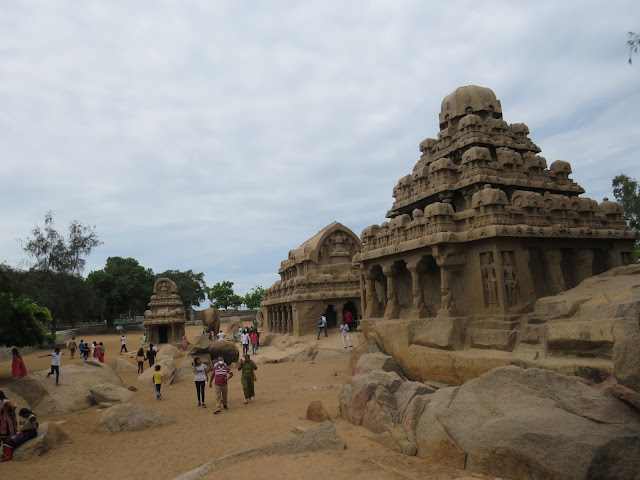Five Rathas in Mamallapuram
When you think of Tamil Nadu, you cannot ignore Mamallapuram. And, when you think of Mamallapuram, you cannot overlook the Five Rathas Complex. The shrines and statues in this complex are some of the best examples of workmanship of Pallava-era sculptors.
This widely visited site has five temples and three statues together. The group of five temples is called Pancha Pandava Rathas.
(Note: I wrote about most of the monuments in Mamallapuram about ten years ago in my blog. This series of articles is my attempt to provide much detailed coverage on all aspects of Pandava Rathas.)
What is a Ratha?
Mamallapuram is a unique site where the Pallavas had done all sorts of experiments using stone. Literally, no stone in the town remains unturned. Everything is found here: large Relief panels, Cave Shrines, Monolith Shrines, and Structural Temples. If a rock face is excavated to make a sanctum, it is called a cave temple. Instead, if a solid rock is cut out to build a free-standing temple, that monolith is called Ratha.
Among all the Rathas, Pandava Rathas are the most popular ones. The word "Ratha" means chariot. Why are these shrines called chariots? As per the standard explanation found in most source materials, as the shrines look like chariots, they are named Rathas.
I am personally not convinced with this explanation. Not all these monolith structures resemble Rathas. I wanted to explore who had initially coined this term. Although it is widely believed that the Europeans used the word "Ratha" for monolith structures, it does not appear to be so.
Thanks to Sri Saurabh Saxena, who runs the famous blog called Puratattva, I came across this book named "The Seven Chambers" by William Chambers. The Appendix section has the full content of "Description of Pagodas at Mavalipuram," a Telugu book written by Kavali Lakshmayya in 1803 CE. He was the first person to call the monolith structures Rathas. I am not sure if he coined this term or gathered this term from the locals. The earlier records called these shrines Pagodas or Vimanas.
Who is Kavali Lakshmayya? Let me brief you...
Perhaps no introduction is needed for Colin Mackenzie, who conducted extensive research on South India for about forty years. A few multilingual Indians assisted Mackenzie in gathering such an immense amount of information and material collections. Kavali Venkata Burriah was a chief interpreter who served Mackenzie. After his untimely death in 1803, his younger brother, the equally competent Kavali Lakshmayya, started helping Mackenzie.
Mackenzie deputed Boriah in 1799 and then Lakshmayya in 1803 to collect records and oral information on Mamallapuram. Thus, the account mentioned earlier in this article was created by Lakshmayya.
An additional anecdote to understand the significance of Lakshmayya's role - In his last will, Mackenzie bequeathed a tenth of his estate to Lakshmayya and his younger brother Ramaswami.
Pancha Rathas - An Introduction
Without visiting the Pancha Ratha Complex, located a little away from the main town, you cannot claim to have seen Mamallapuram. This outstanding monument remains one of the most important and frequently visited sites.
As there are five monolith temples called Rathas located in this complex, it is named Pancha Rathas or Five Rathas. It is also referred to as Aindhu Ratham in Tamil or Pancha Pandava Rathas (meaning the Rathas of five Pandava brothers).
Mamallapuram for Beginners - A book by me
Although the temples are named after the Pandavas, there is nothing to associate with them. Across India, many rock-cut shrines are traditionally associated with the Pandava brothers. Similarly, these temples were also associated with them. Also, many well-known and lesser-known structures of the town were named after the Pandava brothers or Krishna. As we gather from the earliest European records, even a few legends were associated with them. Hence, the tradition of associating these Ratha temples with Pandavas must be prevailing only from the 16th century CE or later.
Each temple in this complex is unique in its design, size, and floor plan. The architectural features seen here were replicated with variations over the next thousand years of temple building in Tamil Nadu. There is a high possibility that their antecedents might be wooden or brick temples in these designs. I disagree with the opinion of a few scholars that they were modeled after the Buddhist Chaityas.
Four temples, namely Draupadi, Arjuna, Bhima, and Dharmaraja Rathas, stand in a single row facing west. All these shrines are carved out of a single rock with a gradual increase in height from north to south. Sahadeva Ratha, the fifth temple, stands apart and faces south.
On the east of Arjuna Ratha, an icon of large Nandi carved out of a single rock is found. The statue of a life-size elephant is standing next to Sahadeva Ratha. In front of Draupadi Ratha, a big statue of a lion is located.
Who built the Rathas?
Many scholars assign the construction of these Rathas to Mamalla, also known as Narasimhavarma Pallava I. There are a few who believed that Paramesvaravarma Pallava I made these structures. However, what Sri R. Nagaswamy states appears to be more logical for me. I agree with him and believe that these five Rathas were constructed by Narasimhavarma II, popularly called Rajasimha Pallava.
The next five articles in this blog will cover all these temples elaboratively. Keep reading!
Happy travelling.





.JPG)
Comments
Post a Comment